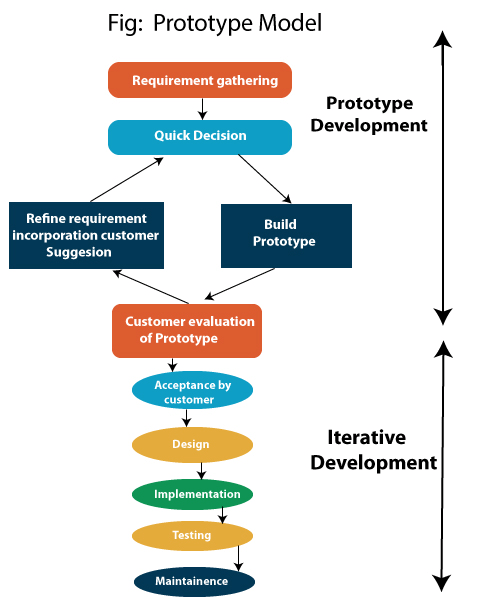Prototype Model
Prototype Model
The prototype model requires that before carrying out the development of actual software, a working prototype of the system should be built. A prototype is a toy implementation of the system. A prototype usually turns out to be a very crude version of the actual system, possible exhibiting limited functional capabilities, low reliability, and inefficient performance as compared to actual software. In many instances, the client only has a general view of what is expected from the software product. In such a scenario where there is an absence of detailed information regarding the input to the system, the processing needs, and the output requirement, the prototyping model may be employed.

Steps of Prototype Model
- Requirement Gathering and Analyst
- Quick Decision
- Build a Prototype
- Assessment or User Evaluation
- Prototype Refinement
- Engineer Product
Advantage of Prototype Model
- Reduce the risk of incorrect user requirement
- Good where requirement are changing/uncommitted
- Regular visible process aids management
- Support early product marketing
- Reduce Maintenance cost.
- Errors can be detected much earlier as the system is made side by side.
Disadvantage of Prototype Model
- An unstable/badly implemented prototype often becomes the final product.
- Require extensive customer collaboration
- Costs customer money
- Needs committed customer
- Difficult to finish if customer withdraw
- May be too customer specific, no broad market
- Difficult to know how long the project will last.
- Easy to fall back into the code and fix without proper requirement analysis, design, customer evaluation, and feedback.
- Prototyping tools are expensive.
- Special tools & techniques are required to build a prototype.
- It is a time-consuming process.
Evolutionary Process Model
Evolutionary process model resembles the iterative enhancement model. The same phases are defined for the waterfall model occurs here in a cyclical fashion. This model differs from the iterative enhancement model in the sense that this does not require a useful product at the end of each cycle. In evolutionary development, requirements are implemented by category rather than by priority.
For example, in a simple database application, one cycle might implement the graphical user Interface (GUI), another file manipulation, another queries and another updates. All four cycles must complete before there is a working product available. GUI allows the users to interact with the system, file manipulation allow the data to be saved and retrieved, queries allow user to get out of the system, and updates allows users to put data into the system.
Benefits of Evolutionary Process Model
Use of EVO brings a significant reduction in risk for software projects.
EVO can reduce costs by providing a structured, disciplined avenue for experimentation.
EVO allows the marketing department access to early deliveries, facilitating the development of documentation and demonstration.
Better fit the product to user needs and market requirements.
Manage project risk with the definition of early cycle content.
Uncover key issues early and focus attention appropriately.
Increase the opportunity to hit market windows.
Accelerate sales cycles with early customer exposure.
Increase management visibility of project progress.
Increase product team productivity and motivations.
Comments
Post a Comment